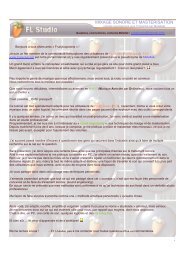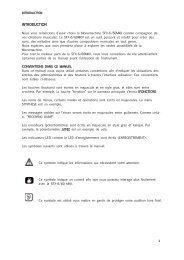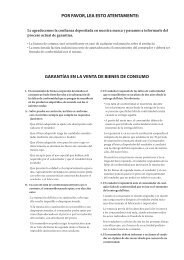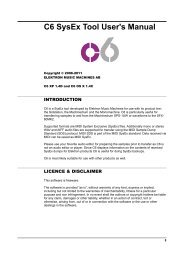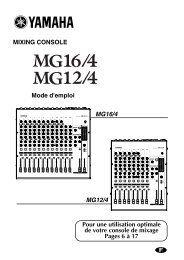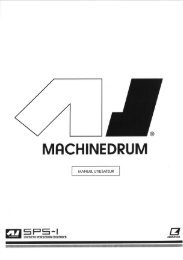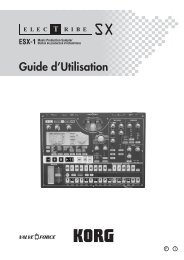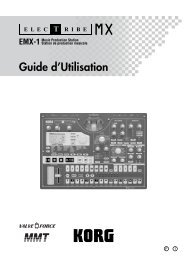Access Virus User Manual - SoundProgramming.Net
Access Virus User Manual - SoundProgramming.Net
Access Virus User Manual - SoundProgramming.Net
Create successful ePaper yourself
Turn your PDF publications into a flip-book with our unique Google optimized e-Paper software.
170 CHAPTER 16<br />
Parameter of the effects menu<br />
REVERB COLOR<br />
This parameters influences the<br />
room’s static frequency response.<br />
Natural reverb will always have<br />
some high-frequency attenuation<br />
since the sound bounces off at<br />
least one wall. REVERB COLOR is<br />
identical to DELAY COLOR; here<br />
you’re dealing with a variable filter<br />
that can act as a low-pass filter<br />
(negative control range) as well as<br />
a high-pass filter (positive control<br />
range). For a natural-sounding<br />
room simulation, you should<br />
always set REVERB COLOR to a<br />
slightly negative value to dampen<br />
the higher frequencies of the room<br />
signal. This will make the effect<br />
sound more authentic and the<br />
room sound warmer. You can, however,<br />
opt to create interesting artificial-sounding<br />
effects by cutting<br />
the lower frequencies radically. To<br />
this end, experiment by varying<br />
the high-pass filter within REVERB<br />
COLOR’s positive control range.<br />
REVERB COLOR is a static filter,<br />
which means it generates a different<br />
effect than that of REVERB<br />
DAMPING, where the amount of<br />
high-end damping is a factor of<br />
time.<br />
In the signal path. the filter is<br />
located at the output of the predelay.<br />
This means that the filter<br />
also influences pre-delay feedback<br />
(REVERB FEEDBACK, see below)<br />
when you use this parameter.<br />
01111111111111111112<br />
1 REVERB<br />
Color -10≤<br />
61111111111111111154<br />
REVERB PREDELAY<br />
This parameter controls the predelay<br />
time of the given room simulation.<br />
In a real room, sound travels quite<br />
a distance and is reflected at least<br />
once before it reaches your ear.<br />
This means that a certain amount<br />
of time elapses before you hear<br />
the earliest reflections of the room<br />
signal. The bigger the room, the<br />
longer it takes for the reflected signal<br />
to reach your ear. This effect is<br />
emulated in a room simulation be<br />
means of a parameter called predelay.<br />
Irrespective of the values set<br />
for the other REVERB parameters,



